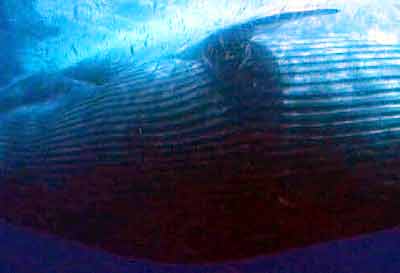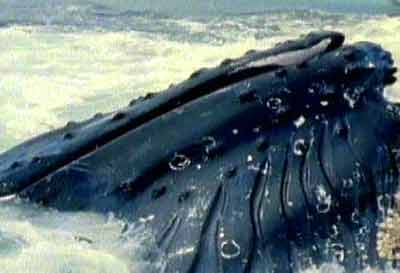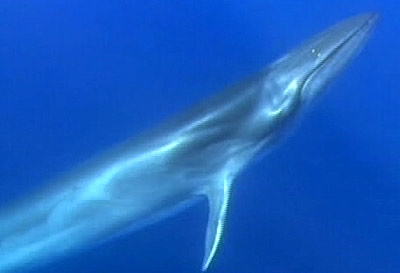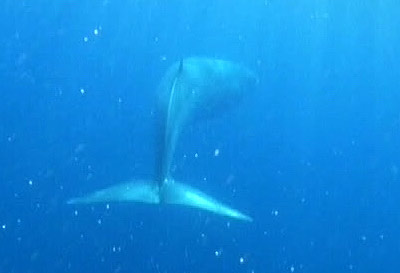 |
|
Slightly larger in area than the Mediterranean,
the Caribbean, at 970,000 sq miles (2,515,900 sq km) is the second largest of the
world's major seas (after the South China Sea), but it is by far the deepest, with an
average depth of 8,450 feet (2,575 meters). The Greater Caribbean boasts the deepest point in the
Atlantic Ocean, the Puerto Rico Trench, at 28,374 feet (8,648 meters) deep. It also
contains numerous underwater banks, coral reefs, mangroves, sea grass beds, and
other diverse marine features
|
This provides a habitat at least part of the year for some 30 species of
whales and dolphins. With the extraordinary diversity and number of islands, islets and cays
stretching from northern South America to offshore Florida, there is a considerable
diversity of potential whale/ dolphin watch opportunities.
Whale watching began in the wider Caribbean in
the early 1980s. Of course, pleasure boaters, sailors and cruise ship
passengers have always enjoyed the company of bow-riding dolphins and passing whales around the
Caribbean. However, it was the discovery of a friendly and accessible group of
spotted dolphins north of Grand Bahama Island in the 1970s that eventually led to the
commercialisation of whale watching. At first, whale and dolphin researchers and film
crews from around the world began to make special pilgrimages there. Following this, a
solid research programme began alongside expanding tourist ventures to watch and swim with
the dolphins on 7- to 10-day tours. About the same time, in waters a little farther
south, New England humpback whale researchers, using photo-identification of
humpback tails to identify the whales, began to realize that most of the North Atlantic
humpbacks were spending their winters between the Bahamas-Turks & Caicos and the
Dominican Republic. These are the mating and calving grounds of Silver, Navidad and
Mouchoir banks. In 1986, as humpback whale watching was just starting up in the
Dominican
Republic, then president Joaquin Balaguer was persuaded to make a far sighted move: to
protect the entire Silver Bank as a marine protected area for humpback whales: The Silver
Bank Humpback Whale Marine Sanctuary. The 'brand name' recognition that
resulted from this effectively kick-started whale watching in the
Dominican Republic. The
country became known as the place where humpbacks mate, calve and raise their
young.
By the early 1990s, the
Dominican Republic was attracting more than 15,000 whale
watch visitors a year and had become the most popular spot in the Caribbean for whale
watching. It still is, although the visitor numbers appear to have levelled off in recent
years at about 20,000 per year. In the late 1980s, a third wave of whale watch
tourism began in the eastern Caribbean. The little country of
Dominica led the
way with trips to see resident sperm whales and an exciting array of smaller whales
and dolphins, some of them rarely seen by whale watchers anywhere in the world. Since then,
whale watching has spread to many of the other islands in the eastern Caribbean and
whale watching in each place offers its own character and selling points. Whale watching is eagerly embraced by many island
economies around the world that are dependent on tourism because it offers a
powerful attraction, additional activity and reason for visitors to come and
stay extra days. Islands such as Maui,
in the Hawaiian Islands, and
Tenerife in the Canary Islands have
experienced several hundred thousand visitors a year going whale watching (10-20 times
the numbers of the entire Caribbean). Even if whale or dolphin sightings cannot be
promised, the chance of seeing them adds value to any marine nature cruise or excursion.
This value is not limited to tourism revenues. Whales and dolphins help confer a
powerful, attractive identity on many communities and offer an experience that visiting
tourists remember, tell their friends about, and return to enjoy themselves. Whales and
dolphins also introduce people to the marine environment and help teach stewardship of
marine resources. Living on a shrinking planet with a shared ocean, we can all stand to
be reminded of this important lesson.
|
|
Around Rincón, Puerto Rico, the annual arrival
of the humpback whales during the winter provides an exciting community focus,
with thousands of land-based whale watchers visiting the Punta Higuera
Lighthouse and spending the day at the park. Whales are not the only reason people
visit, but they are a key reason during the winter, and park concessions report
increases related to whale watching. The whales can be seen from the
lighthouse, as well as from various points on the hills around
Rincón.
|
|
 |
|
From the Roseau area of
Dominica, total revenues, most of which go into the community, have now reached an annual $1 million
USD (including food, accommodation, travel, souvenirs, as well as the
cost of the tickets themselves).
On the island of Carriacou, in the Grenadines
of Grenada, the educational programme of the Kido Project provides a
community basis for some of its activities which include whale watching and
other marine and land-based programmes.
In and around the town of Samaná, in the
Dominican Republic, there are new businesses and infrastructure directly
attributable to the increase in visitors during the whale watch season. Community members
have started to improve and extend facilities and to encourage land-based
whale watching as well. Although much work remains to be done so that
local people can receive the maximum benefits from whale watching, it has
clearly become part of the essential fabric of the town. Whale watching is having a real impact on local
economies in these and other Caribbean locales. At present, however, the
West
Indies, or Greater Caribbean, is 'lightly developed' for whale watching. The only area that
shows development to rival other areas of the world is Samaná Bay. There, in 1998,
21,784 people went whale watching in a three-month season — an average of more than
7,000 people a month. By comparison, whale watching in southern New England and at
Tadoussac, Québec, Canada, attracted an estimated 600,000 to 1 million participants over
3-5 months (120,000-333,000 people per month). Thus, the potential for whale watching in the
Greater Caribbean is outstanding and largely untapped through most of the region. What
is needed, for those islands that might wish to start or enhance their whale watching, is
a careful development plan both to learn from some of the mistakes made in other parts of
the world, as well as to work on establishing and promoting their own unique brand
of whale watching.
|
 |
|
The Bahamas (Commonwealth).
The main islands are Grand Bahama Island,
Great Abaco (Abaco Islands),
Bimini Islands, Andros
Island, New Providence, Eleuthera, Cat Island, San Salvador, Exuma, Rum Cay, Long
Island, Crooked Island, Acklands Island, Mayaguana Island, and Great
Inagua Island.
Population: 265,300.
Land area: 13,864 sq
km.
Tourist arrivals by air:
1,617,595 (-0.9% on prev. yr.)
Tourist arrivals by cruise ship:
1,743,736 (+3.4% on prev. yr.) |
|
Total Tourist Expenditures:
$1,415.9 million USD.
Tourism Budget: $53.9
million USD.
GDP at factor cost:
$3,939 million USD.
1994 figures on whale watching:
1,500 people and total revenues of $2.475 million USD.
1998 figures on whale watching:
1,800 people and total revenues of $2.97 million USD (prov.)
Whale-watching ports (current or potential):
West End, Grand Bahama; Alice Town, Bimini; Hope Town, Elbow Cay, Great Abaco.
Land-based viewing sites:
Hole-in-the-Wall Lighthouse, Great Abaco; Elbow Cay lighthouse, Great Abaco; North Bimini.
Whale-watching potential:
Outstanding.
(Figures above are latest figures for 1997, except as noted.)
The Bahamas includes more than 700 islands
scattered over more than 100,000 square miles (260,000 sq kms) of ocean. Only 24
of them are inhabited, and the most developed islands are in the northern part of the
country, nearest to the United States. These islands, which are where the main dolphin
watching/swimming tours occur, both gain and suffer from proximity to the USA. They
gain in sheer numbers of tourists who can depart from southeast Florida ports and
arrive in the islands in a few hours by boat or less than an hour by plane. But on the negative
side, the nearest islands can be crowded with tourists, and the big cruise ships as well
as the self-contained boat tours from Florida, such as those used for dolphin watching/swimming,
leave comparatively little money in the Bahamas. The Bahamas has certainly captured
the interest of great numbers of tourists, but the country does not always capture as much
of the tourist dollar as it could. Nevertheless, the revenues are considerable, as
is the potential for capturing a higher percentage of them. Tourism is the largest industry in the Bahamas by
a substantial measure. In 1996, some 3.4 million vacationers and cruise ship
visitors arrived and spent $1.45 billion USD. Nearly half of these (1.6 million) were one or
two-day cruise ship stopovers. The Bahamas (mainly Nassau) receives about 50% of all cruise
ship passenger visits in the Caribbean. In 1997, these figures (except cruise ship visitors)
declined slightly due to refurbishment of hotel properties on Grand Bahamas. Still, the
projected number of visitors is 4 million a year by 2000, 80% of which are expected to come
from North America, mainly the USA. Since 1992, the government has promoted a huge
development programme for tourism, investing in infrastructure as well as overseas
promotion. The introduction of laws such as the Hotels Encouragement Act, which eliminated
property taxes for hotel owners, has led to substantial new building and restoration, and
hotels with as few as five rooms can qualify for preferential treatment. Eco-friendly
tourism development in some of the more remote islands is also being encouraged.
Dolphin watching/ swimming began in the late
1970s on Little Bahama Bank. As word spread that the dolphins would visit boats
and would not disperse when divers entered the water, cetacean researchers and many
enthusiasts from around the world made a pilgrimage here to swim with them. The Bahamas
quickly became one of a dozen prime whale and dolphin watching spots in the world. For much of the last two decades, dolphin
watching and swimming in the Bahamas has originated mainly with US (Florida-based)
operators who make extended diving or swim-with-dolphin excursions into Bahamian waters
for a week or ten days. These have been largely self-contained trips, although the
boats stop at West End or other Bahamian ports to pay customs fees and take on supplies.
The economic impact, besides the sales price of the tour which goes to the (US)
operator, includes a night or more in the Bahamas on shore, with a minimum of $130-180 USD spent on
food, hotel and shopping. The US boats bringing tourists to the dolphins are
charged $1,000 USD plus 4 percent of their passenger income.
The dolphin swimming trips have focused on the
waters north of Grand Bahama Island. The relative remoteness of this location
and the fact that people need to commit a week or ten days to a trip have helped ensure
that the numbers of people and boats have not become a severe management problem, though at
times in summer it has been overcrowded and some boat captains are less
polite and patient than others. In the past couple years, however, some of existing operators
have opened up trips to the Biminis where mainly spotted dolphins and some bottlenose
dolphins are found much closer to shore and where boats can operate with greater
comfort and flexibility for their customers. This has relieved some of the pressure on the
populations of dolphins north of Grand Bahama. The Biminis are also closer to the coast
of south-eastern Florida, so trip journeys are shorter from Florida and tour operators have
the option of allowing people to stay on shore and take day trips to see the dolphins.
This has the potential at least to provide more local income for the Bahamas. In 1998, some operators of the Bahamas
swim-with-dolphin trips noticed a slight decline in interest, with fewer people signing up
for the trips. Several factors may be involved: As a result, a few operators have recently
stopped offering the tours while dive operators have reduced or eliminated the numbers
of days visitors can spend with dolphins. Other operators have permanently moved
their operations to the Biminis. In addition, some operators have starting shifting
the focus of their trips from ecotourism or mainstream tourism to 'human potential' tourism.
This niche market is generally respectful toward the wild dolphins, but does little in the
way of gathering photo-IDs useful for scientific programmes. In some cases, there is
little education beyond 'New Age'-oriented education. It would be beneficial if ecological
concepts could also be included and promoted. The other dolphin tours are mostly recreationally
oriented, based around diving tours or yachting cruises. Few carry naturalists
or scientists or have a substantial educational programme. This needs to be urgently
addressed. Denise Herzing, a scientist who carries some passengers on her
research-oriented trips north of Grand Bahama, has promoted suggested guidelines for swimming with
the dolphins and distributed them through the entry port of West End on Grand
Bahama. The Bahamas has vast dolphin watching potential
and even some whale watching potential in the 'Out Islands' or, as the
Bahamian tourism ministry calls them, the 'Family Islands' (Abacos, Andros, Eleuthera, Cat Island,
Ragged Island, Crooked Island, Great Inagua, Mayaguana, etc.) These essentially
include all of the Bahamas except the two populated islands of New Providence and Grand
Bahama where respectively Nassau and Freeport are located (80% of the population live
here). The Family Islands extend out from the somewhat developed Andros, Abacos and
Eleuthera, to the far remote and undeveloped southern and eastern parts of the
Bahamas. A great deal of work needs to be done in terms of cetacean surveys and in
establishing a basic infrastructure before whale or dolphin tourism can be considered, particularly
in the more remote areas. The Bahamian Tourism ministry supports the development of
these islands and the director-general of tourism has even been quoted as saying that they
are the future for tourism in the Bahamas. As of 1997, there were 264,000 tourist
arrivals in the Family Islands, a figure which has climbed steadily since 1995, and now
represents a 16.3% share of all tourist arrivals to the Bahamas. Currently, Abacos, which
is the island adjacent to Grand Bahama, represents the 'frontier' in terms of dolphin
watching, so there is still considerable unexplored territory in the Bahamas.
| By far the best weather season is summer, with
some possibilities for late spring. (Hurricane season is June to November, but the
period late August-September usually offers the worst weather conditions.) The
dolphins live in the Bahamas all year round but trips cannot be consistently and confidently
offered outside of summer. To develop more winter trips in the Bahamas, it would be
necessary to offer them as day trips, for dolphin populations that are close to land, and with the
flexibility that dolphin trips would only occur when the weather and seas are
reasonable |
|
 |
This way, if tourists on a week or ten-day trip could build some flexibility in terms of
when they would take the trips, it would be possible to have a good chance to see dolphins.
Probably the best base for such tourism would be Abacos where some day trips and
multi-day dolphin tours have been offered from Marsh Harbor in the past. However, for this
to develop into regular tours, a local operator or company would need to set up a base
on Abacos (or another island), ideally combining day tours with a partly land-based
component. This might be easiest to do on Abacos where there is a known inshore
bottlenose
dolphin population, as well as others offshore, and the chance to see other whale and
dolphin species. For nearly 10 years, Bahamian Diane Claridge's
and American Ken Balcomb's Bahamas Marine Mammal Survey, supported largely
through Earthwatch, has been based out of Abacos, first at
Tilloo Cay and now from
Hole-in-the-Wall Lighthouse. Every year, they have combed the surrounding area, focusing
on Northeast and Northwest Providence Channels, the deep passage through the Bahama
Banks that connects the open North Atlantic with Florida coastal waters and the Gulf
Stream. The long-term goal of this excellent project is to characterise the marine
mammals of the Bahamas for both scientific and conservation purposes. Click to
see video of
spotted
dolphins
 |
|
They have identified
20 species of cetaceans, including (in order of how commonly they are seen)
spotted
dolphins and bottlenose dolphins year round, plus
sperm whales, dwarf & pygmy sperm
whales, humpback whales, false killer whales, and pilot whales, as well as rare
tropical beaked whales. |
The survey has photographically identified the resident
population of 90 some bottlenose dolphins off central
Abaco, as well as finding five new
cetacean species in the islands.
 |
|
Most exciting of all is a life-history study on the rare
dense-beaked whale which lives in the deep waters offshore. About 100 individual
dense-beaked
whales have been photo-identified and a number of them have been resighted within the
year and from year to year, suggesting that at least some of them are residents. |
Since 1992,
an average of 70 EarthCorps volunteers per year have participated in these multi-day
educational field study tours for the Bahamas Marine Mammal Survey. Each pays $1,800 USD to
participate for 10 days, 80 percent of which covers expenses. In 1996, Claridge and Balcomb started Bahama
Naturalist Expeditions and began taking whale watchers on day tours. They escorted
150 people on day tours at a cost of $85 USD per person but the tours stopped after 8
months when they embarked on a new project, moving to the more remote southern tip
of Abacos, to Hole-in-the-Wall Lighthouse. Besides being a good land-based
lookout when the waters are calm, Claridge and Balcomb would like to turn it into a
well-equipped research station and ecotourist lodge. While they have continued to lead the
Earthwatch tours, they are now planning to offer multi-day land-based and marine tours out
of splendid Abaco National Park (with its pine and hardwood forests and its native
endangered Bahama parrots) which will feature whale and dolphin watching. At present, however, despite in principle
agreements made with the Bahamian government, they have been waiting 3 1/2 years to
hear whether a lease arrangement can be made for the lighthouse and surrounding land,
which would allow them to invest in restoring the existing buildings for the now
automated lighthouse. They want to build classrooms for university students, a lab and
darkroom for scientific work and low key environmentally-friendly cottages for ecotourists.
It would be difficult to find a more worthy plan for this area, or one that would
better help to diversify tourism while providing education and science as part of the
deal. In other parts of the world such valuable multi-purpose facilities would receive
substantial government funding. Also located on Abaco is
Marsh Harbour — a centre
for boating in the Bahamas, and a good departure point for farther afield and
the more remote islands and islets. East of Marsh Harbour, on
Elbow Cay, there is another
lighthouse with a superb view out on the Atlantic. The town also has a small cetacean
museum on Bay St with a map showing whale sightings in nearby waters.
Here are a few highlights and possibilities from
some of the various other islands:
Off Andros, humpback whales have been found in
Tongue of the Ocean, the deep channel on the eastern side of
Andros, in winter.
Andros also has dolphins and the third longest reef in the world after the
Great Barrier Reef and Belize.
At Six Shilling Cay and Egg Island (west of
northern Eleuthera), pilot whales have been seen repeatedly.
At Cay Lobos, Guinchos Rock and
Orange Cay, in
the far southern part of the Bahamas (30 miles from Cuba), fishermen often
report sightings of spotted dolphins.
Great Inagua — the most southern of the
Bahamas, lying about half way between the Turks and Caicos Islands and
Cuba — has a
national park, the Inagua National Park, and stunning birdlife with its
system of interior lakes. It may also be a good environment for various dolphins and
whales, but is as yet unexplored. Humpback whales have been seen passing by the
island en route to their breeding grounds north of the Dominican Republic.
Near Long Island and Mayaguana Island in
winter, humpback whales are regularly reported.
Cat Island has Mt. Alvernia, the Bahamas
highest peak, which offers 360° views over protected inshore waters to the west as well
as the open Atlantic to the east — good potential cetacean waters.
But these are just a few leads. The Bahamas has
large areas, which remain unsurveyed and unexplored for cetaceans. With two
thirds of the Greater Caribbean cetacean species reported here already, the
possibilities are outstanding for creating new cetacean-based marine nature trips.
In future, the Bahamas might profitably develop a
solid policy toward ecotourism. At present, the image of the Bahamas may be
confused by the presence of a number of shore-based captive cetacean facilities which
allow visitors to feed and/or swim with captive or what are sometimes called semi-wild
dolphins (such as at Sanctuary Lagoon on Grand Bahama and
Blue Lagoon Island near Nassau).
These facilities have been widely challenged and even condemned by ecotourists,
certain scientists and a wide range of NGOs who do not recommend breaking up dolphin
families and bringing them into captivity, even if the conditions are by human
definition 'semi-wild'. The need to establish regulations and define an ecotourism policy is
not unique to the Bahamas; indeed it is a concern throughout the world. It is necessary to
have more than just basic laws against animal harassment; what is needed is a
comprehensive policy and programme to address these matters. It is a key part of the image
building of a country.
|
|